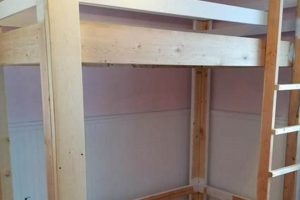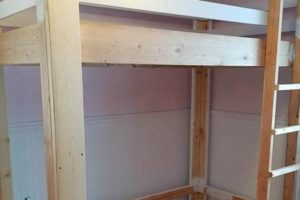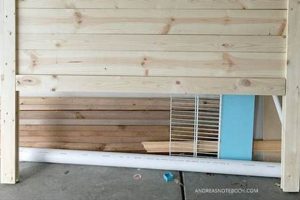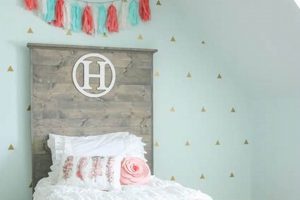A self-constructed platform designed to support a queen-sized mattress is a foundational element in bedroom furniture. This structure, typically built from wood or metal, provides elevation and stability for the mattress, influencing sleep quality and overall bedroom aesthetics. The dimensional requirements of a queen-sized mattress, commonly 60 inches wide and 80 inches long, dictate the dimensions of the supporting framework.
Constructing one’s own sleeping platform offers significant advantages. It allows for customization to suit individual needs and preferences, such as adjusting height or incorporating storage solutions. Further, it can be a more economical alternative to purchasing pre-fabricated options. Historically, individuals have crafted their own furniture out of necessity and to express personal style; this practice continues today, fueled by the desire for unique and cost-effective solutions.
Subsequent sections will elaborate on the various design considerations, material selection processes, and step-by-step instructions pertinent to building a sturdy and aesthetically pleasing support system. These resources will facilitate the successful completion of the endeavor, ensuring a durable and comfortable sleep environment.
Construction Advice
The following guidelines are provided to ensure the successful and structurally sound construction of a sleeping platform designed for a queen-sized mattress.
Tip 1: Precise Measurement and Planning: Accurate dimensions are crucial. Measure the queen mattress and account for a snug, but not overly tight, fit within the framework. Draw a detailed plan before commencing construction, noting all dimensions and material requirements.
Tip 2: Material Selection: Opt for high-quality lumber such as kiln-dried pine or hardwood for the frame. Ensure the wood is free from knots and imperfections that could compromise structural integrity. Consider the aesthetic properties of the wood to complement the bedroom decor.
Tip 3: Reinforcement and Support: Adequate center supports are essential to prevent sagging and ensure even weight distribution. For a queen-sized platform, a minimum of three evenly spaced center supports is recommended. Consider incorporating additional support beams for enhanced stability.
Tip 4: Secure Fastening Techniques: Utilize appropriate screws, nails, and wood glue for secure joinery. Predrilling pilot holes will prevent wood splitting and ensure stronger connections. Corner brackets can further reinforce the frame’s corners.
Tip 5: Smooth Finish and Edge Treatment: Sand all surfaces thoroughly to eliminate splinters and sharp edges. Apply a sealant or stain to protect the wood and enhance its appearance. Consider rounding over the edges to prevent accidental bumps and scrapes.
Tip 6: Leg Stability: Ensure the legs are securely attached and capable of supporting the combined weight of the frame, mattress, and occupants. Use sturdy leg mounting plates and consider reinforcing the legs with additional bracing.
Tip 7: Ventilation Considerations: Allow for adequate ventilation beneath the mattress to prevent moisture buildup and mold growth. This can be achieved through spacing between slats or the inclusion of ventilation holes in a solid platform surface.
Adherence to these guidelines will result in a sturdy, functional, and aesthetically pleasing platform that provides a comfortable and supportive sleep surface.
The subsequent sections will delve into specific design variations and customization options, allowing for further personalization of the construction project.
1. Frame Material Selection
Frame material selection is a foundational consideration in the construction of a self-made queen-sized sleeping platform. The choice of material directly influences the structural integrity, longevity, and overall aesthetic of the completed structure. Inadequate material selection can result in premature failure of the frame, compromising the stability of the mattress and potentially leading to injury. Conversely, appropriate material selection ensures a robust and durable platform capable of supporting the weight of the mattress and its occupants for an extended period.
Consider the example of a frame constructed from untreated softwood prone to warping and insect infestation. Such a frame is likely to exhibit sagging, instability, and eventual collapse under load. In contrast, a frame constructed from kiln-dried hardwood, such as oak or maple, demonstrates superior strength, resistance to warping, and longevity. Furthermore, the aesthetic properties of the chosen material contribute significantly to the overall design. Reclaimed wood, for instance, offers a rustic charm, while metal frames provide a more modern, industrial aesthetic. The material’s workability, cost, and availability are also practical considerations.
In summary, informed material selection is paramount to the successful completion of a stable and long-lasting self-made queen-sized sleeping platform. By carefully evaluating factors such as strength, durability, cost, and aesthetic properties, the constructor can mitigate risks and ensure a superior final product. The selection process presents a significant opportunity to tailor the platform to individual needs and preferences, though challenges remain in navigating the wide range of available materials and their respective properties.
2. Support Structure Design
The design of the support structure is intrinsically linked to the success of a self-constructed queen-sized sleeping platform. The effectiveness of this design directly influences the frame’s ability to bear weight, resist deformation, and provide a stable and comfortable sleep surface. A poorly designed support system can lead to premature sagging, structural failure, and an uneven sleeping surface. Conversely, a well-engineered support structure distributes weight evenly, maintains the frame’s integrity over time, and enhances overall sleep quality. For example, a platform with insufficient center supports will likely sag under the weight of the mattress and occupants, resulting in discomfort and potential damage to the mattress itself. Therefore, understanding the principles of structural mechanics and load distribution is crucial for designing an adequate support system.
Practical applications of sound support structure design involve incorporating features such as closely spaced slats, reinforced center beams, and sturdy leg attachments. Slats should be constructed from durable materials and spaced appropriately to prevent mattress indentation and ensure adequate ventilation. Center beams, typically running the length of the frame, provide additional support and prevent bowing. Leg attachments should be securely fastened to the frame, utilizing appropriate hardware and reinforcement to withstand the forces exerted upon them. Consider the scenario of a platform designed with widely spaced, thin slats; this configuration is unlikely to provide adequate support, leading to mattress sagging and an uneven sleeping surface. A more robust design, incorporating closely spaced, thicker slats and a reinforced center beam, will provide a more stable and durable foundation.
In summary, a well-considered support structure is essential for a functional and long-lasting self-made queen-sized sleeping platform. Neglecting this aspect can lead to structural deficiencies and a compromised sleep experience. Addressing these challenges through careful planning, material selection, and the application of sound engineering principles will ensure a structurally sound and comfortable foundation. The practical significance of this understanding lies in its direct impact on the durability, stability, and overall quality of the finished product.
3. Precise Dimensional Accuracy
In the construction of a self-made queen-sized sleeping platform, meticulous adherence to accurate dimensions is paramount. Deviations from specified measurements can compromise the structural integrity, mattress support, and overall usability of the completed structure. Neglecting dimensional precision can result in a platform that is either too small to adequately support the mattress, leading to overhang and instability, or too large, resulting in unsightly gaps and potential safety hazards.
- Mattress Fit and Support
Accurate dimensions are crucial for ensuring a proper fit between the mattress and the platform frame. An undersized frame will cause the mattress to overhang, leading to uneven weight distribution and potential sagging or damage to the mattress edges. An oversized frame, conversely, allows the mattress to shift, creating an unstable sleeping surface. A precise fit provides uniform support and prolongs the mattress’s lifespan. For example, if the platform is even one inch too narrow, the mattress may bow and compress leading to early wear and tear.
- Structural Integrity
Dimensional accuracy directly affects the structural integrity of the platform. If components are not cut to the precise lengths specified in the design, the frame may not be square or level, resulting in an unstable and potentially unsafe structure. This is particularly important for ensuring that weight is distributed evenly across all support points. An example is a leg that is cut slightly too short, causing the weight to shift onto the other three legs potentially causing one to give way.
- Joint Alignment and Stability
Accurate measurements are essential for proper alignment of joints and secure fastening of frame components. Misaligned joints can compromise the strength and stability of the structure, leading to premature failure. Precise cuts and accurate placement of fasteners are necessary to ensure that all joints are strong and capable of withstanding the stresses placed upon them. If the joints are not perfectly aligned, they cannot be glued and secured properly, significantly reducing their strength.
- Aesthetic Considerations
While primarily functional, dimensional accuracy also contributes to the aesthetic appeal of the finished product. A well-constructed platform with precise dimensions will have clean lines and a professional appearance, enhancing the overall look of the bedroom. Inaccuracies in measurements can result in a visually unappealing structure that detracts from the room’s decor. A platform built with care and precision can enhance the aesthetic appeal of the sleeping space. Minor dimensional inaccuracies can cause the platform to appear unprofessional and amateurish.
In conclusion, precise dimensional accuracy is not merely a detail in the construction of a self-made queen-sized sleeping platform; it is a fundamental requirement. Neglecting this aspect can lead to a range of problems, from compromised structural integrity and mattress support to aesthetic deficiencies. By prioritizing accuracy in all phases of the construction process, one can ensure a durable, stable, and aesthetically pleasing sleeping platform.
4. Secure Joint Connections
The structural integrity of a self-constructed queen bed base hinges critically on the security of its joint connections. These connections, the points where individual components are united, bear the concentrated forces exerted by the mattress and occupants. Inadequate joint security precipitates instability, premature wear, and potential structural failure. The relationship is direct: weak joints initiate a cascade of negative effects, diminishing the lifespan and functionality of the entire sleeping platform. For instance, consider a bed base assembled with poorly glued and inadequately screwed joints. Over time, these joints will loosen, leading to creaking, wobbling, and eventual collapse under sustained load. Therefore, implementing robust and reliable jointing techniques is not merely advisable; it is a fundamental requirement for creating a safe and durable queen bed base.
Practical methods for achieving secure joint connections involve selecting appropriate fasteners, employing proper joinery techniques, and reinforcing vulnerable areas. Screws, bolts, and wood glue represent standard fastener options, each possessing distinct strengths and limitations. Joinery techniques encompass mortise and tenon, dovetail, and biscuit joints, each offering varying levels of strength and complexity. Corner brackets and metal plates serve as supplementary reinforcement, particularly at high-stress areas. For example, the corners of the bed base, where the side rails connect to the legs, are subject to significant forces. Reinforcing these corners with metal brackets significantly enhances their resistance to racking and failure. Similarly, utilizing mortise and tenon joints for the main frame provides a robust and long-lasting connection capable of withstanding substantial loads.
In summary, secure joint connections constitute an indispensable element of a well-constructed queen bed base. Failure to prioritize this aspect introduces significant risks to the structural integrity and longevity of the platform. Overcoming the challenges associated with selecting appropriate materials, mastering joinery techniques, and implementing reinforcement strategies yields a stable, durable, and safe sleeping environment. This understanding is fundamentally important because it translates directly into the quality and lifespan of the finished product, ensuring a comfortable and secure rest for the user.
5. Load-Bearing Capacity
Load-bearing capacity represents a critical design parameter for any self-constructed queen bed base. It dictates the maximum weight the structure can safely support without experiencing deformation or failure. A properly engineered bed base must accommodate the combined weight of the mattress, bedding, and occupants, ensuring structural integrity and preventing potential safety hazards.
- Material Selection and Load Distribution
The choice of materials directly impacts the load-bearing capacity. Hardwoods, such as oak or maple, possess greater compressive strength than softwoods like pine. The design must account for the material’s properties to effectively distribute the load. For instance, a bed base constructed from pine requires more robust support structures than one built from oak to achieve the same load-bearing capacity. The spacing and dimensions of support beams and slats significantly influence the weight distribution across the frame.
- Joint Integrity and Connection Strength
The strength of the joints connecting the various components plays a pivotal role in the overall load-bearing capacity. Weak or poorly executed joints can become points of failure under stress. Secure joinery techniques, such as mortise and tenon or dovetail joints, combined with appropriate fasteners and adhesives, are essential. Reinforcing corners with brackets or metal plates further enhances joint strength and prevents racking under load. Insufficiently secured joints compromise the entire structure’s ability to withstand the intended weight.
- Span and Support Configuration
The distance between support points, or span, affects the deflection and bending stresses experienced by the frame members. Longer spans require stronger materials or more substantial support structures to maintain adequate load-bearing capacity. Optimizing the placement and number of support beams is crucial. A queen bed base with a large unsupported span in the center is prone to sagging under load, reducing its stability and potentially damaging the mattress.
- Leg Design and Attachment
The legs must be designed and attached to the frame to withstand the vertical load. The number, size, and material of the legs directly influence the bed base’s ability to support the intended weight. Reinforcing the leg attachment points to the frame is essential to prevent them from shearing or collapsing under stress. Using appropriately sized and securely fastened leg mounting plates helps distribute the load evenly and prevents premature failure.
These factors collectively determine the load-bearing capacity of a self-made queen bed base. Overlooking any of these aspects can lead to a structure that is unsafe or prone to premature failure. Careful consideration of material properties, joint integrity, support configuration, and leg design is essential for creating a durable and reliable platform that provides years of comfortable and secure use. Calculating the load-bearing capacity will ensure the base can support both mattress and its occupants.
6. Surface Finish Quality
The quality of the surface finish applied to a self-made queen bed base is not merely an aesthetic consideration; it is directly linked to the durability, hygiene, and longevity of the structure. A poorly executed surface finish can lead to premature degradation of the materials, creating conditions conducive to microbial growth and insect infestation. Conversely, a well-applied and durable finish provides a protective barrier, enhancing resistance to moisture, scratches, and everyday wear. The selection and application of the finish, therefore, represent a critical step in the construction process. Consider the scenario of a bed base constructed from wood that is left unfinished or coated with a low-quality varnish. The exposed wood will readily absorb moisture, leading to warping, cracking, and the development of mold or mildew. A properly sealed surface, on the other hand, prevents moisture penetration, preserving the wood’s integrity and inhibiting microbial growth.
The practical implications of surface finish quality extend beyond mere aesthetics. A smooth, well-sealed surface is easier to clean and maintain, promoting a hygienic sleeping environment. Rough or porous surfaces can trap dust, allergens, and other contaminants, contributing to respiratory problems and allergic reactions. Moreover, the choice of finish can influence the overall durability of the bed base. A durable finish, such as a polyurethane coating, provides a robust protective layer that resists scratches, stains, and abrasion, extending the lifespan of the structure. The application of a high-quality finish increases the bed base’s resilience. This ensures its capacity to withstand regular use without diminished structural or aesthetic attributes.
In summary, surface finish quality is a crucial determinant of the long-term performance and hygiene of a self-made queen bed base. Prioritizing the selection and application of a durable, non-porous finish provides a protective barrier against moisture, wear, and microbial growth, contributing to a healthier and more durable sleeping environment. The challenges associated with selecting the appropriate finish and mastering application techniques are outweighed by the significant benefits in terms of longevity, hygiene, and overall value. Incomplete or sub-par surface finishes may require earlier repairs.
7. Aesthetic Compatibility
Aesthetic compatibility, in the context of a self-constructed queen-sized sleeping platform, refers to the harmonious integration of the bed base’s design, materials, and finish with the existing dcor and stylistic preferences of the bedroom. The visual integration of the furniture piece represents more than a cosmetic concern; a discord between the bed base’s aesthetic and the surrounding environment can disrupt the room’s ambiance and diminish its overall appeal. A cause-and-effect relationship exists: a well-considered design enhances the room’s aesthetic, while a poorly conceived design detracts from it. For example, a minimalist, modern bedroom featuring clean lines and neutral colors would likely be negatively impacted by a rustic, ornate bed base constructed from reclaimed wood. Conversely, a bedroom with a farmhouse aesthetic would find such a bed base to be complementary.
The importance of aesthetic compatibility is further underscored by its influence on the perceived value and functionality of the self-made sleeping platform. A bed base that seamlessly integrates with the existing dcor enhances the room’s overall aesthetic, creating a cohesive and visually pleasing space. This integration contributes to a sense of harmony and tranquility, promoting relaxation and improving sleep quality. The functionality of the bed base is also affected, as the aesthetic design can dictate storage solutions, headboard integration, and overall space utilization. Consider a small bedroom where a bed base with built-in storage drawers can simultaneously enhance the room’s aesthetic and provide practical storage solutions, maximizing space efficiency. A failure to consider storage features can make the overall utility of the furniture piece lower.
In summary, aesthetic compatibility is a critical component of a successful do-it-yourself queen bed base project. It extends beyond mere visual appeal, influencing the room’s ambiance, perceived value, and functionality. Addressing this aspect requires careful consideration of the existing dcor, stylistic preferences, and practical needs. Challenges may arise in balancing personal preferences with practical considerations and budgetary constraints. Careful planning and attention to detail are essential to achieving a harmonious and visually pleasing result, leading to a sleeping space that is both functional and aesthetically satisfying. The impact of aesthetic compatibility cannot be overstated.
Frequently Asked Questions About DIY Queen Bed Base Construction
This section addresses common inquiries regarding the design, construction, and maintenance of self-made queen-sized sleeping platforms. The information provided is intended to assist individuals in making informed decisions throughout the building process.
Question 1: What is the minimum recommended height for a queen bed base?
The minimum recommended height for a queen bed base is dependent upon individual preferences and physical capabilities. However, a height of 12 to 18 inches from the floor to the top of the mattress is generally considered standard. This range facilitates ease of access and egress for most adults. Consideration should also be given to under-bed storage requirements.
Question 2: What type of wood is most suitable for constructing a durable queen bed base frame?
Hardwoods, such as oak, maple, or birch, are generally preferred for constructing a durable queen bed base frame due to their superior strength and resistance to wear. However, softwoods, such as pine or fir, can be used if appropriately reinforced and treated to prevent warping or insect infestation. The selection of lumber must consider factors such as cost, availability, and aesthetic preferences.
Question 3: How many support slats are required to adequately support a queen-sized mattress?
The number of support slats required depends on the slat width, material, and spacing. Generally, a minimum of five to seven evenly spaced slats is recommended. The slats should be constructed from durable lumber and securely attached to the frame to prevent sagging. Closer slat spacing provides enhanced support and is recommended for heavier mattresses or occupants.
Question 4: What is the best method for joining the corners of a queen bed base frame?
Several methods can be employed for joining the corners of a queen bed base frame, each offering varying degrees of strength and complexity. Mortise and tenon joints, dovetail joints, and reinforced corner brackets are all viable options. The selection of the joining method should consider the skill level of the builder and the desired aesthetic appearance.
Question 5: Is it necessary to apply a finish to a self-made queen bed base?
Applying a finish to a self-made queen bed base is highly recommended. A finish protects the wood from moisture, scratches, and wear, extending its lifespan and enhancing its aesthetic appeal. A variety of finishes are available, including paints, stains, varnishes, and polyurethanes. The selection of the finish should consider the desired appearance, durability requirements, and ease of application.
Question 6: How can squeaking be prevented in a self-made queen bed base?
Squeaking in a self-made queen bed base can be prevented by ensuring that all joints are securely fastened and that there is no friction between moving parts. Lubricating joints with wax or applying felt pads to contact points can also reduce squeaking. Regularly inspecting and tightening fasteners is essential for maintaining a squeak-free bed base.
Adhering to these guidelines will aid in the construction of a robust and functional queen bed base. Additional considerations may arise depending on specific design choices and individual circumstances.
The subsequent section will provide detailed step-by-step instructions for constructing a basic queen bed base.
Conclusion
The preceding analysis has comprehensively examined the multifaceted aspects of a self-constructed queen-sized sleeping platform. From material selection and support structure design to dimensional accuracy, joint integrity, load-bearing capacity, surface finishing, and aesthetic compatibility, each element contributes significantly to the overall durability, functionality, and visual appeal. Thorough consideration of these factors is essential for ensuring a structurally sound and aesthetically pleasing end product.
The successful creation of a lasting sleeping platform requires diligent planning, careful execution, and a commitment to quality craftsmanship. While challenges may arise during the construction process, the potential rewards a personalized, cost-effective, and enduring piece of furniture justify the effort. Prospective constructors are encouraged to meticulously review the outlined principles and to adapt them to their specific needs and resources to achieve a satisfying and long-lasting foundation.







